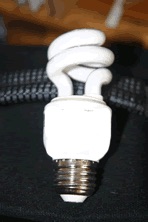
Blinded And Poisoned By The Light
Written by Attorney Jonathan Emord
Category: Articles
Published: 02 March 2011

Home is supposed to be a place of refuge but that is about to change. A federal law passed in 2007 will soon make it impossible for Americans to keep their homes and work places illuminated without assuming a very high risk of exposure to a toxic metal, mercury. The Congress has thus violated the rights of individuals to achieve a perceived communal good, energy efficiency. This certainly is not the first time Congress has devalued individual liberty and life to pursue a self-serving political agenda and it will not be the last.
Under the Energy Independence and Security Act of 2007 Congress decided that it knew better than the American people how best to illuminate residences and work places. That law bans a basic item ubiquitous worldwide for over one hundred years: the incandescent light bulb.
 The EPA advised Congress that spiral tube Compact Fluorescent Lights (CFLs) containing are 75% more energy efficient than incandescent bulbs and that a ban on incandescent bulbs would force consumers to buy CFLs. Under the Energy Independence and Security Act, Congress has banned the sale of all 100 watt incandescent bulbs effective January 1, 2012; all 75 watt bulbs effective January 1, 2013; and all 40 and 60 watt bulbs effective January 1, 2014.
The EPA advised Congress that spiral tube Compact Fluorescent Lights (CFLs) containing are 75% more energy efficient than incandescent bulbs and that a ban on incandescent bulbs would force consumers to buy CFLs. Under the Energy Independence and Security Act, Congress has banned the sale of all 100 watt incandescent bulbs effective January 1, 2012; all 75 watt bulbs effective January 1, 2013; and all 40 and 60 watt bulbs effective January 1, 2014.
To use light metaphors, the ban on incandescent bulbs is a product of dim wits. It is anything but a bright idea.
CFLs are little mercury bombs. They are held aloft in light fixtures awaiting that inevitable moment when they will be shattered. They each contain between 3 and 30 milligrams of mercury in gas filled tubes and cannot operate without mercury. Mercury in any form and in very small amounts is toxic. Even before the mandate takes effect, between 2 and 4 tons of mercury enter the environment each year from public use of CFLs. That figure is about to grow exponentially. The mercury emitted not only harms the environment, it also poses an immediate threat to everyone who places a CFL in a home or work place.
CFLs are far more expensive than incandescent bulbs. They also require special care in disposal. They may not be thrown away in the trash for general disposal. They have to be recycled by facilities capable of handling mercury. If a CFL breaks in the home or work place, it creates a HAZMAT issue. Chronic exposure to comparatively small amounts of mercury can cause neurologic, gastrointestinal, and renal system damage. The fetal brain is particularly susceptible to injury from mercury and so pregnant women and infants are most vulnerable. Mercury vaporizes at room temperature and is well absorbed through inhalation. It is lipid soluble; it passes through the alveoli in the lungs and directly into the blood stream and red blood cells. Mercury poisoning can occur through vapor inhalation, ingestion, or absorption through the skin. The EPA has determined that .1 mcg of mercury per kilogram per day is the safe upper limit for human exposure.
In February of 2008 the state of Maine released the Maine Compact Fluorescent Lamp Breakage Study Report. Maine researchers evaluated room air quality affected by the breakage of CFLs. It also evaluated the safety of cleanup methods. The researchers found that when a single CFL breaks, it releases mercury vapor into a room at levels that can exceed federal guidelines for chronic exposure by as much as 100 times.
CFLs are made in China. Hundreds of the Chinese factory workers who make the CFLs have been hospitalized for mercury poisoning.
Many jurisdictions require that spent CFLs not be included in general waste disposal but be recycled at a significant cost to the consumer. It is illegal to dispose of CFLs in general landfills in California, Illinois, Indiana, Minnesota, Ohio, and Wisconsin. Other states appear destined to pass similar disposal limits.
The EPA has issued recommendations on how consumers should handle CFL breakage because of the risk of toxicity. If a CFL breaks in the home, EPA recommends: (1) that people and pets be removed immediately from the room where the break took place and that no contact be made with the surfaces contaminated; (2) that windows and doors to the outside be opened; (3) that all air conditioning, heating, and HVAC units be shut off; (4) that stiff paper or cardboard be obtained for clean-up along with sticky tape, a damp paper towel or disposable wipes, and a glass jar with a metal lid or a sealable plastic bag; (4) that the room be reentered after open air ventilation and that the glass and powder be lifted with the stiff paper or cardboard and be placed in the glass jar with the metal lid or the sealable plastic bag (if the latter, the bag is to be immediately placed outside because the vapors can travel through plastic); (5) that the remaining glass and powder be lifted with sticky tape and the tape be disposed of in the jar or plastic bag: (6) that the area be wiped with a damp paper towel or disposable wipes and that those be placed in the jar or plastic bag: (7) that no vacuuming occur in the room because that may spread the mercury powder or vapor; (8) that local and state health agencies be contacted to advise on proper recycling of the jar or plastic bag; (9) that hands be washed; (10) that the room be aired out for several hours with air conditioning, heating, and HVAC shut off; and (11) that when next the room is to be vacuumed, the air conditioning, heating, and HVAC be shut off and that windows and doors to the outside be opened. Carpets pose a particular problem because mercury powder can become embedded in them. Consequently, if a carpet is contaminated, the part affected has to be cut out, enclosed in plastic, and sent immediately for recycling by a mercury recycling facility.
In short, by force of law Congress is insisting on the contamination of every American home. Congress has denied Americans their freedom of choice and has compelled them to become energy efficient, regardless of the health consequences. True to form, Congress once again presumes to know better than the individual American what is in his or her own best interests.
The ban on bulbs is a very simple and direct example of just how paternalistic, controlling, and intrusive the federal government has become. It reveals how coercive the influence of federal power can be in our daily lives.
The 2010 mid-term elections brought into office many who share antipathy for paternalistic government. Most, if not all, of them favor repeal of this bill. On February 18, 2011, Senator Mike Enzi introduced the Better Use of Light Bulbs (BULB) Act to repeal the 2007 ban on incandescent bulbs. A companion bill has been introduced in the House by Congressman Joe Barton. In anticipation of the bans, many manufacturers of incandescent bulbs have stopped production. Even if the Enzi bill passes, there will likely be bulb shortages. Wise consumers are buying up large quantities of incandescent bulbs because they have learned the most basic lesson of history: those with political power can never be trusted.
© 2011 Jonathan W. Emord – All Rights Reserved
Jonathan W. Emord is an attorney who practices constitutional and administrative law before the federal courts and agencies. Congressman Ron Paul calls Jonathan “a hero of the health freedom revolution” and says “all freedom-loving Americans are in [his] debt . . . for his courtroom [victories] on behalf of health freedom.” He has defeated the FDA in federal court a remarkable seven times, six on First Amendment grounds, and is the author of Amazon bestsellers The Rise of Tyranny, and Global Censorship of Health Information. For more info visit Emord.com.
Website: Emord.com
E-Mail: jwemord@gmail.com

Leave a Reply